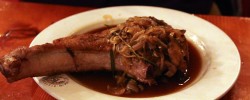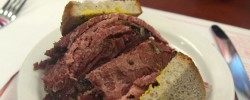Au Pied de Cochon (Montreal, Quebec, Canada)
As I talked about in my previous post, Quebec is known for it’s culinary heritage, particularly that resulting from the French fur trading heritage, so there are a lot of rich, hearty dishes. Poutine, in particular, is a Quebecois favorite, consisting of fries, cheese curd (and it must be curd, poutine doesn’t work with shredded cheese), and gravy. But it’s almost impossible to do a web search on poutine in Montreal without getting a recommendation for Au Pied de Cochon. Hiding behind a most unassuming storefront on Rue Duluth a few blocks east of St Denis, chef Martin Picard has opened a modest restaurant that is, quite frankly, a shrine to two things: traditional Quebecois cuisine, and meat itself. Au Pied de Cochon (the name literally mean’s “pig’s foot”), the restaurant is basically dedicated to large slabs of freshly roasted meat, served up with impossibly rich sauces, and even the more-than-occasional slab of foie gras. And it’s become quite the foodie destination in Montreal (which even before Au Pied de Cochon had quite the reputation as a food tourism destination), meaning that every night it’s open, PdC is packed to the gills, and it took some groveling for us to get a 9pm reservation.



